2007 CHEVROLET TRAIL BLAZER manual transmission
[x] Cancel search: manual transmissionPage 181 of 574
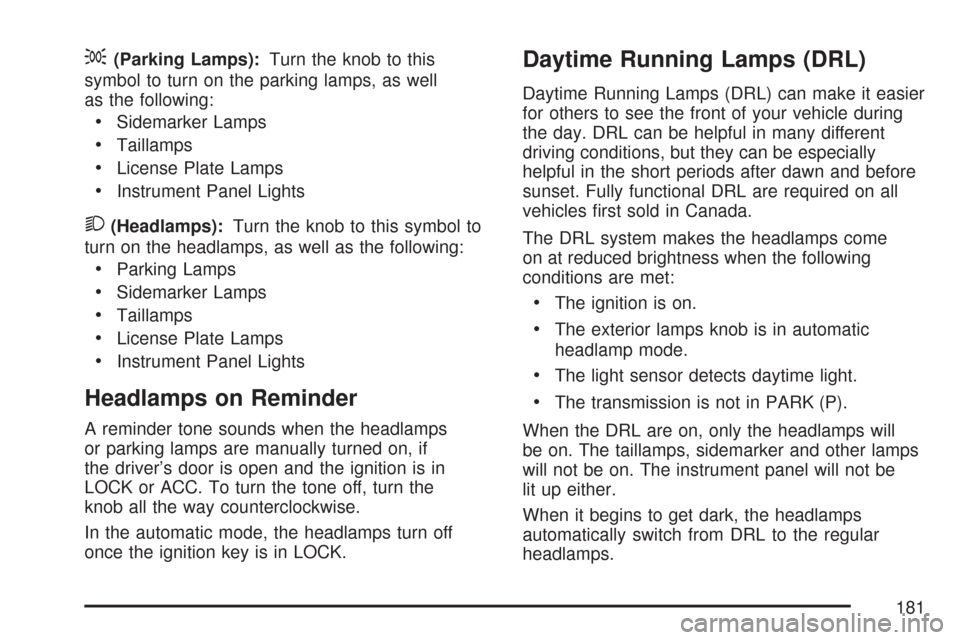
;(Parking Lamps):Turn the knob to this
symbol to turn on the parking lamps, as well
as the following:
Sidemarker Lamps
Taillamps
License Plate Lamps
Instrument Panel Lights
2(Headlamps):Turn the knob to this symbol to
turn on the headlamps, as well as the following:
Parking Lamps
Sidemarker Lamps
Taillamps
License Plate Lamps
Instrument Panel Lights
Headlamps on Reminder
A reminder tone sounds when the headlamps
or parking lamps are manually turned on, if
the driver’s door is open and the ignition is in
LOCK or ACC. To turn the tone off, turn the
knob all the way counterclockwise.
In the automatic mode, the headlamps turn off
once the ignition key is in LOCK.
Daytime Running Lamps (DRL)
Daytime Running Lamps (DRL) can make it easier
for others to see the front of your vehicle during
the day. DRL can be helpful in many different
driving conditions, but they can be especially
helpful in the short periods after dawn and before
sunset. Fully functional DRL are required on all
vehicles �rst sold in Canada.
The DRL system makes the headlamps come
on at reduced brightness when the following
conditions are met:
The ignition is on.
The exterior lamps knob is in automatic
headlamp mode.
The light sensor detects daytime light.
The transmission is not in PARK (P).
When the DRL are on, only the headlamps will
be on. The taillamps, sidemarker and other lamps
will not be on. The instrument panel will not be
lit up either.
When it begins to get dark, the headlamps
automatically switch from DRL to the regular
headlamps.
181
Page 364 of 574
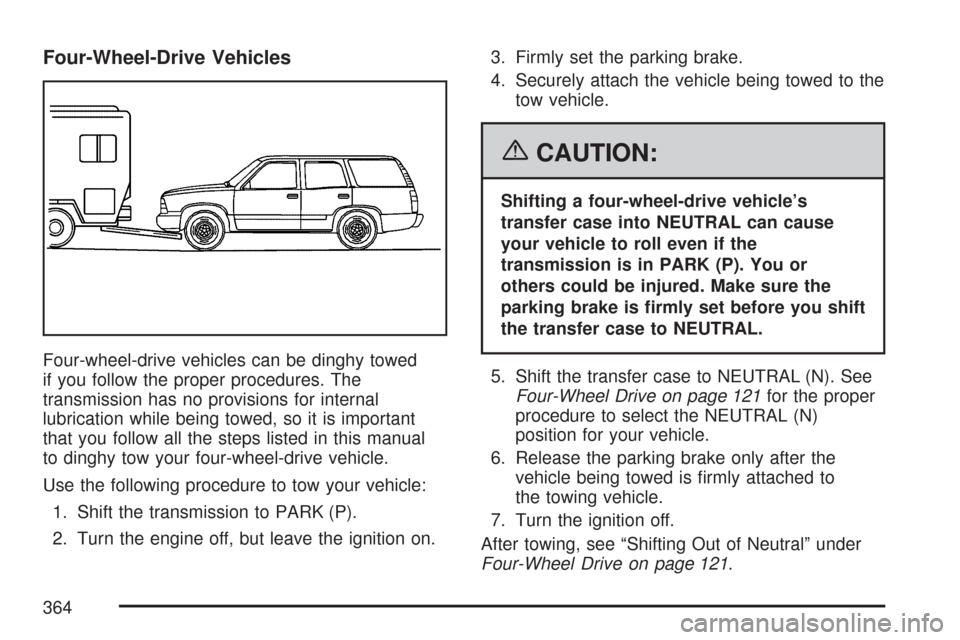
Four-Wheel-Drive Vehicles
Four-wheel-drive vehicles can be dinghy towed
if you follow the proper procedures. The
transmission has no provisions for internal
lubrication while being towed, so it is important
that you follow all the steps listed in this manual
to dinghy tow your four-wheel-drive vehicle.
Use the following procedure to tow your vehicle:
1. Shift the transmission to PARK (P).
2. Turn the engine off, but leave the ignition on.3. Firmly set the parking brake.
4. Securely attach the vehicle being towed to the
tow vehicle.
{CAUTION:
Shifting a four-wheel-drive vehicle’s
transfer case into NEUTRAL can cause
your vehicle to roll even if the
transmission is in PARK (P). You or
others could be injured. Make sure the
parking brake is �rmly set before you shift
the transfer case to NEUTRAL.
5. Shift the transfer case to NEUTRAL (N). See
Four-Wheel Drive on page 121for the proper
procedure to select the NEUTRAL (N)
position for your vehicle.
6. Release the parking brake only after the
vehicle being towed is �rmly attached to
the towing vehicle.
7. Turn the ignition off.
After towing, see “Shifting Out of Neutral” under
Four-Wheel Drive on page 121.
364
Page 380 of 574
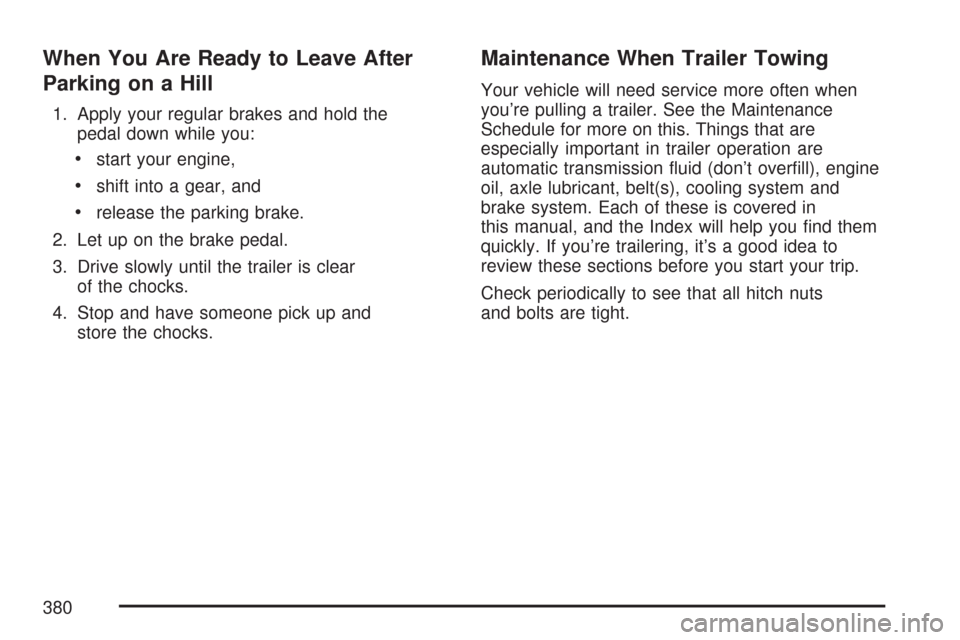
When You Are Ready to Leave After
Parking on a Hill
1. Apply your regular brakes and hold the
pedal down while you:
start your engine,
shift into a gear, and
release the parking brake.
2. Let up on the brake pedal.
3. Drive slowly until the trailer is clear
of the chocks.
4. Stop and have someone pick up and
store the chocks.
Maintenance When Trailer Towing
Your vehicle will need service more often when
you’re pulling a trailer. See the Maintenance
Schedule for more on this. Things that are
especially important in trailer operation are
automatic transmission �uid (don’t over�ll), engine
oil, axle lubricant, belt(s), cooling system and
brake system. Each of these is covered in
this manual, and the Index will help you �nd them
quickly. If you’re trailering, it’s a good idea to
review these sections before you start your trip.
Check periodically to see that all hitch nuts
and bolts are tight.
380
Page 433 of 574
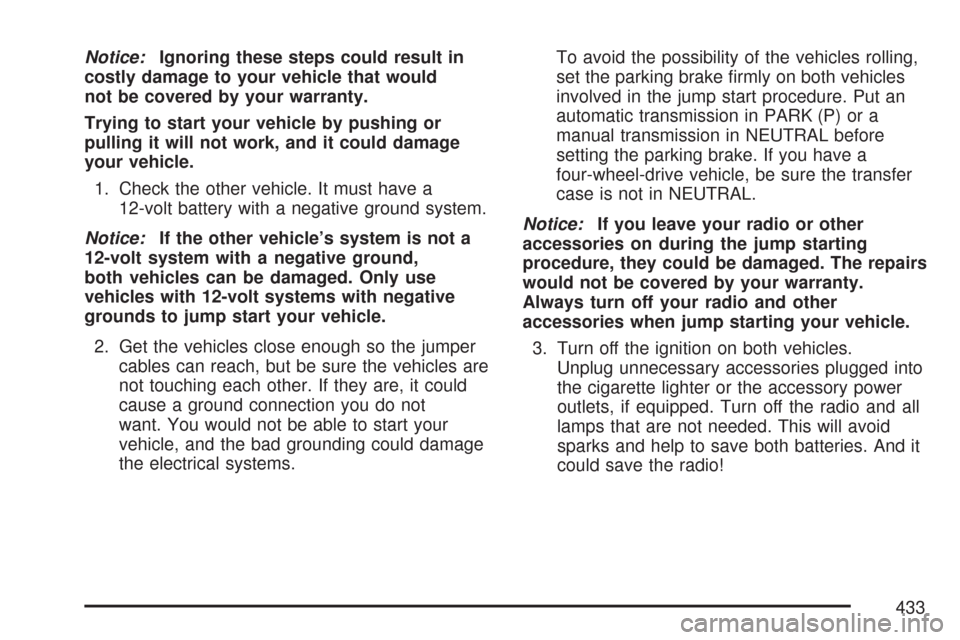
Notice:Ignoring these steps could result in
costly damage to your vehicle that would
not be covered by your warranty.
Trying to start your vehicle by pushing or
pulling it will not work, and it could damage
your vehicle.
1. Check the other vehicle. It must have a
12-volt battery with a negative ground system.
Notice:If the other vehicle’s system is not a
12-volt system with a negative ground,
both vehicles can be damaged. Only use
vehicles with 12-volt systems with negative
grounds to jump start your vehicle.
2. Get the vehicles close enough so the jumper
cables can reach, but be sure the vehicles are
not touching each other. If they are, it could
cause a ground connection you do not
want. You would not be able to start your
vehicle, and the bad grounding could damage
the electrical systems.To avoid the possibility of the vehicles rolling,
set the parking brake �rmly on both vehicles
involved in the jump start procedure. Put an
automatic transmission in PARK (P) or a
manual transmission in NEUTRAL before
setting the parking brake. If you have a
four-wheel-drive vehicle, be sure the transfer
case is not in NEUTRAL.
Notice:If you leave your radio or other
accessories on during the jump starting
procedure, they could be damaged. The repairs
would not be covered by your warranty.
Always turn off your radio and other
accessories when jump starting your vehicle.
3. Turn off the ignition on both vehicles.
Unplug unnecessary accessories plugged into
the cigarette lighter or the accessory power
outlets, if equipped. Turn off the radio and all
lamps that are not needed. This will avoid
sparks and help to save both batteries. And it
could save the radio!
433
Page 514 of 574
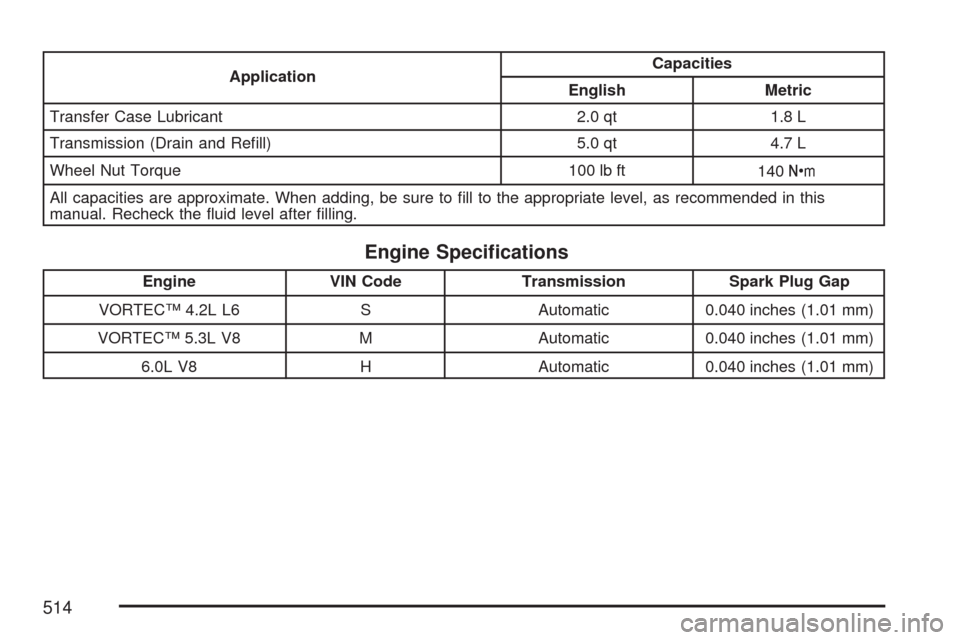
ApplicationCapacities
English Metric
Transfer Case Lubricant 2.0 qt 1.8 L
Transmission (Drain and Re�ll) 5.0 qt 4.7 L
Wheel Nut Torque 100 lb ft
140Y
All capacities are approximate. When adding, be sure to �ll to the appropriate level, as recommended in this
manual. Recheck the �uid level after �lling.
Engine Speci�cations
Engine VIN Code Transmission Spark Plug Gap
VORTEC™ 4.2L L6 S Automatic 0.040 inches (1.01 mm)
VORTEC™ 5.3L V8 M Automatic 0.040 inches (1.01 mm)
6.0L V8 H Automatic 0.040 inches (1.01 mm)
514
Page 554 of 574
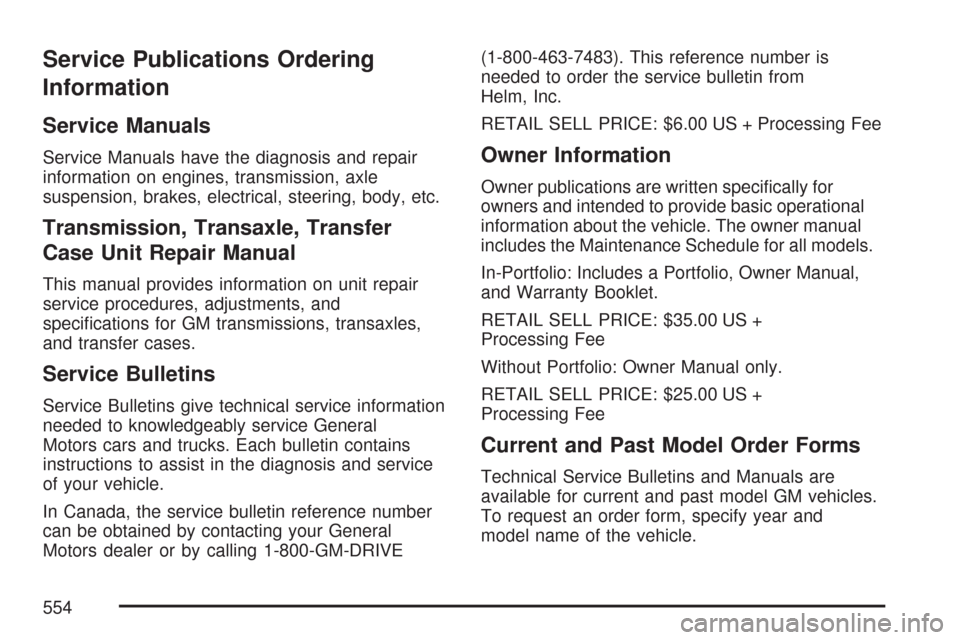
Service Publications Ordering
Information
Service Manuals
Service Manuals have the diagnosis and repair
information on engines, transmission, axle
suspension, brakes, electrical, steering, body, etc.
Transmission, Transaxle, Transfer
Case Unit Repair Manual
This manual provides information on unit repair
service procedures, adjustments, and
speci�cations for GM transmissions, transaxles,
and transfer cases.
Service Bulletins
Service Bulletins give technical service information
needed to knowledgeably service General
Motors cars and trucks. Each bulletin contains
instructions to assist in the diagnosis and service
of your vehicle.
In Canada, the service bulletin reference number
can be obtained by contacting your General
Motors dealer or by calling 1-800-GM-DRIVE(1-800-463-7483). This reference number is
needed to order the service bulletin from
Helm, Inc.
RETAIL SELL PRICE: $6.00 US + Processing Fee
Owner Information
Owner publications are written speci�cally for
owners and intended to provide basic operational
information about the vehicle. The owner manual
includes the Maintenance Schedule for all models.
In-Portfolio: Includes a Portfolio, Owner Manual,
and Warranty Booklet.
RETAIL SELL PRICE: $35.00 US +
Processing Fee
Without Portfolio: Owner Manual only.
RETAIL SELL PRICE: $25.00 US +
Processing Fee
Current and Past Model Order Forms
Technical Service Bulletins and Manuals are
available for current and past model GM vehicles.
To request an order form, specify year and
model name of the vehicle.
554
Page 560 of 574
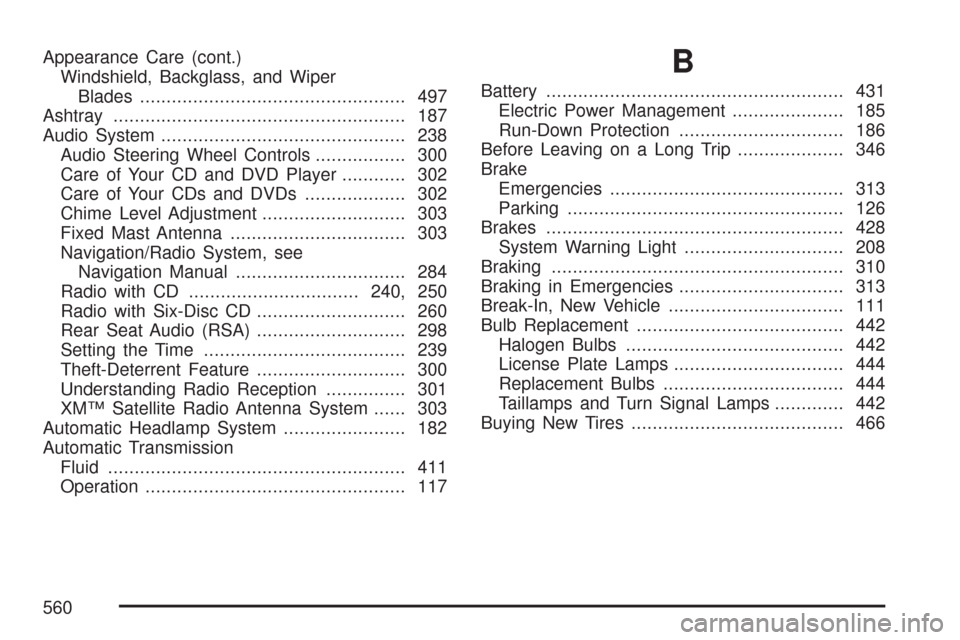
Appearance Care (cont.)
Windshield, Backglass, and Wiper
Blades.................................................. 497
Ashtray....................................................... 187
Audio System.............................................. 238
Audio Steering Wheel Controls................. 300
Care of Your CD and DVD Player............ 302
Care of Your CDs and DVDs................... 302
Chime Level Adjustment........................... 303
Fixed Mast Antenna................................. 303
Navigation/Radio System, see
Navigation Manual................................ 284
Radio with CD................................240, 250
Radio with Six-Disc CD............................ 260
Rear Seat Audio (RSA)............................ 298
Setting the Time...................................... 239
Theft-Deterrent Feature............................ 300
Understanding Radio Reception............... 301
XM™ Satellite Radio Antenna System...... 303
Automatic Headlamp System....................... 182
Automatic Transmission
Fluid........................................................ 411
Operation................................................. 117B
Battery........................................................ 431
Electric Power Management..................... 185
Run-Down Protection............................... 186
Before Leaving on a Long Trip.................... 346
Brake
Emergencies............................................ 313
Parking.................................................... 126
Brakes........................................................ 428
System Warning Light.............................. 208
Braking....................................................... 310
Braking in Emergencies............................... 313
Break-In, New Vehicle................................. 111
Bulb Replacement....................................... 442
Halogen Bulbs......................................... 442
License Plate Lamps................................ 444
Replacement Bulbs.................................. 444
Taillamps and Turn Signal Lamps............. 442
Buying New Tires........................................ 466
560